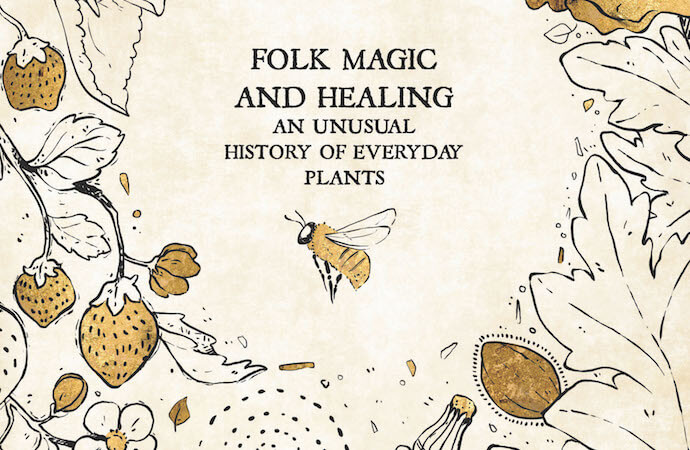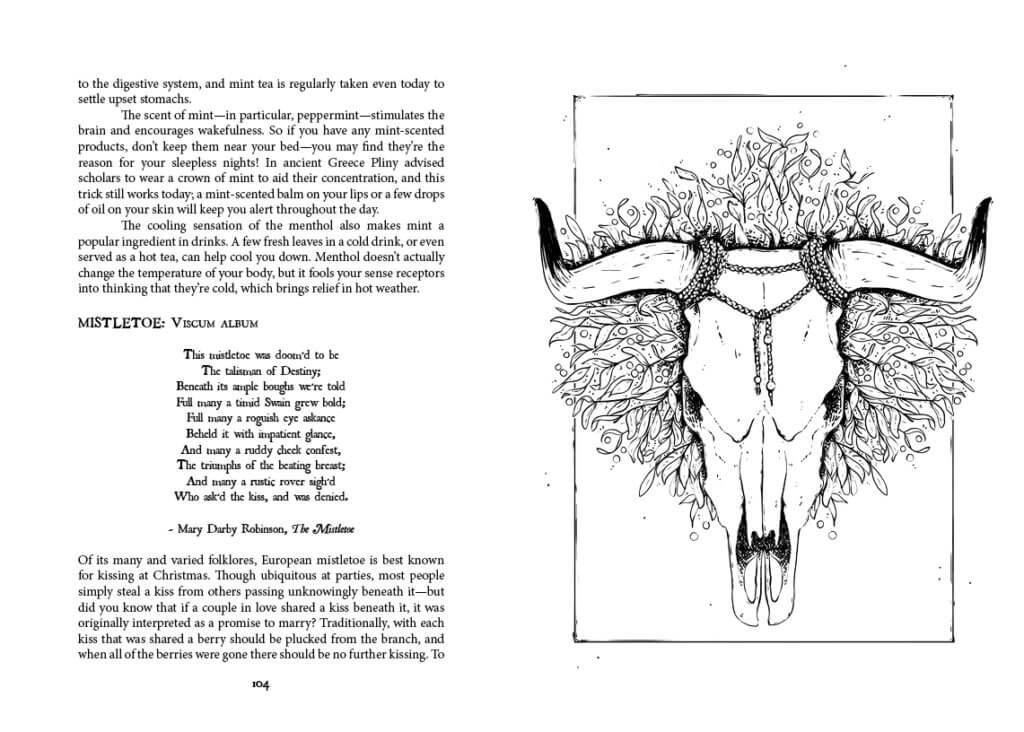Folk Magic and Healing: An Unusual History of Everday Plants
Fez Inkwright
Liminal 11
October 2, 2019
The latest addition to the Liminal 11 catalogue is a new edition of Folk Magic and Healing: An Unusual History of Everyday Plants. Previously self-published by British author and illustrator Fez Inkwright, it’s a book about the folklore of plants and their history within our mythology and culture from ancient times all the way to today. I love the idea of bringing self published books to a wider audience, and the Liminal 11 edition is a gorgeous hardcover with gold leaf on the cover that’s well made and feels great to hold.
The book itself is set up like a reference guide. It begins with a brief, thoughtful introduction about the ways plants have been important to people throughout history, in cooking and medicine, religion and art. There are a few short essays with a little background on how to use plants medicinally, with instructions on how to actually make things like oils and tinctures. Then, it jumps straight into talking about individual plants, which are listed alphabetically and have corresponding entries with information about what they’re good for medicinally, how they’ve been used throughout history and what they’re associated with, magically and mythologically.
I’m not sure if the book is necessarily meant to be read cover to cover or not. It would certainly be easy to pick up and flip to the entry for a certain plant or herb at the moment you wanted to know something about it. That said, I did read it from front to back, and I found the format pretty charming. The individual entries are short and so rich with interesting folklore that it was very pleasant to pick up the book, spend twenty minutes reading a handful of entries in a row, and then set it down to come back to it later. In fact, there’s something inherently calming about it.
Inkwright’s appreciation for the beauty of ordinary, commonplace plants is apparent on every page. It really encourages you to slow down and spend a few minutes thinking deeply about something you may normally overlook. (After reading that apples were considered to be the most magical kind of tree because the seeds form a five pointed star when you cut the fruit in half, I found myself deep in contemplation about the idea of someone in ancient times seeing the shape of the seeds and being overcome with religious awe.)
Since they make up most of the book, let’s talk about what the individual plant entries are like. First of all, every single one is accompanied by a black and white botanical drawing, also done by Inkwright. These illustrations feature impeccably clean linework and are consistently beautiful. Some of them are also quite magical, portraying the plants alongside arcane symbolism relevant to their history, like henbane depicted around a skull because it’s associated with the river Styx in Greek mythology. (I’m not sure that the drawings are detailed enough to reliably use for identification of unknown plants, though, which makes sense, since it’s more of a history book than a field guide.) Each entry also begins with a quote from existing poetry or prose, mainly Victorian era, which were clearly carefully selected and helped me get into the thoughtful mindset that the book encourages. My favorite is Oscar Wilde: “Land sweet the hops upon the Kentish leas, and sweet the wind that lifts the new-mown hay…”
The facts about each plant are a bit of a grab bag. Some are biological reference, like facts about how and where the plant grows, what time of year it flowers, and when it’s best harvested. Others are historically focused, like the ways plants were used medicinally and the superstitions people had about them in certain time periods. For instance, the juice from bluebell bulbs was once used for bookbinding. And of course, many facts are also magical! Uses in magic and spellwork are covered, which are based in old traditions, but could still be useful for modern practitioners of magic, like the fact that brambles were often traditionally used in binding spells. It also talks about the role of some plants in ritual historically, such as how birch sticks were thought to be able to summon a Russian forest demon. (I wouldn’t necessarily expect green witches today to try and recreate this!) Myths from a variety of different cultures are discussed, which are interesting, particularly when they contradict each other!
Not every entry touches on all of these categories, which makes it feel conversational, as if Inkwright carefully curated exactly what information I would want to know about each plant. My favorite thing about the different kinds of information is that the mundane and the fantastical are all presented together, with no real distinction between them. No judgement is ever passed about which facts may be more valuable than others, and the stories about the bookbinding sap and the Russian forest demon are discussed as if each is as likely to be useful to you in everyday life as the other.
One other thing this book does really well is convey context in an insightful and fascinating way. Not only does it discuss the beliefs people used to have about certain plants, but it also tries to explain why. For instance, perhaps the reason why people believed a certain botanical vinegar concoction could protect them from contracting the black plague was because the herbs it contained repel insects. (If people using the potion were less likely to get bitten by ticks, it’s entirely plausible they would also be less susceptible to plague. Fascinating, right?) It also explains why specific plants have magical significance because of myths they were mentioned in. Anemone, for example, was often used in rituals relating to death because in Greek mythology, the flower was believed to have bloomed in places where Aphrodite’s tears fell onto the soil while she was grieving over Adonis.
Overall, the Liminal 11 edition of the book is gorgeous. Having not seen Inkwright’s self published edition, I can’t really say if it’s more beautiful. (Given the care put into it by the author, I’d believe the original may have also been very beautiful!) But it’s certainly more accessible and brought to my attention this wonderful little treasury that I may not have stumbled upon otherwise, which is a very worthwhile accomplishment, seeing as it brought a little quiet joy into my life.




